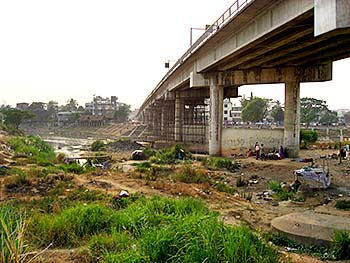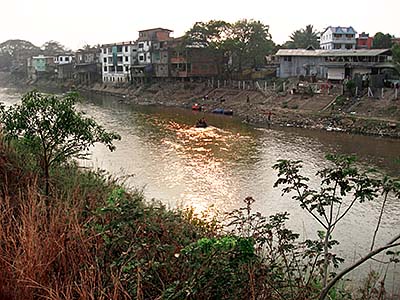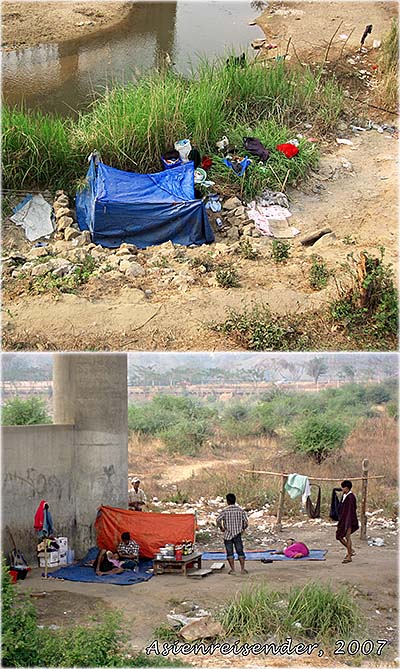1.
Mae Sot
Mae Sot is a city in the western part of Thailand. It's situated in the mountains, and close to a border crossing to Burma/Myanmar.

The 1997 bridge over the Moei River links Thailand with Burma/Myanmar. Image by Asienreisender, 2/2007
The place lies on a high plain with rice and cotton agriculture. From Mae Sot to the border, which is drawn by the Moei River, it's a few kilometers. Songtheaws (vehicles of local transport) run frequently to and fro. The two countries are connected by a newer concrete bridge, which was opened in 1997. A former, older bridge was destroyed in civil war combats in the 1980s. On the Burmese side of the border lies the town of Myawaddy.
2.
Population, Economy and Business
Mae Sot has a long tradition as a market place. It reaches back at least to the Sukothai era. For a time in the 14th century it must have been also part of Lanna. After the Second World War were decades of civil war going on on the Burmese side of the border; the fights between the government troops and the local Karen People didn't always stop at the border; sometimes the fighting happened also on the Thai side.

The Burmese town of Myawaddy. Won't be a big obstacle to cross the river. Image by Asienreisender, 2/2007
The place is of growing importance for being an important trade post and placed along Asian Highway No. 1, a major traffic connection between India on one side and Vietnam and China on the other. Together with the border crossing at the Three Pagodas Pass, Mae Sot is the most important land border between the two countries.
In the last census of 2012, Mae Sot's inhabitants were counted by around 32,000. That's only the smaller part of the population, those with Thai nationality. Due to the proximity to the border, Mae Sot is the target for massive immigration from the desolate and impoverished neighbour state. There are about 106,000 people from Burma/Myanmar staying in Mae Sot, given as an official number. It's estimated that another 100,000 live here unregistered. These people searched refuge from political persecution and from poverty. Among them are many people of the Karen and Shan ethnicities.

There is a huge refugee crisis in the world. Desaster capitalism with all it's unscrupulous machinations, particularly expropriaton and warfare, creates a steadily growing population of drop-outs. The refugee crisis at Thailand's border seldom appears in the world news, but it's a long-term problem which will not be solved. However, there are industries who then willfully exploit even the misery of such people. Images and photocomposition by Asienreisender, 2/2007, 2016
The great number of refugees contributes to the enormous growth of Mae Sot. The impoverished Burmese bring goods like woodwork, gems like jade and a number of crafts to exchange it for the many things who are not available in Burma, like electronics, motorbikes and food. These border towns are always pretty shady places, for a number of cross-border activities are going on, many of them illegal. Smuggling is a common phenomenon, particularly in teak and other precious woods, but also gem, drug, gun smuggling and human trafficking happen.
The vulnerability of the refugees attracts many vultures who are going to prey on them. In early 2015, the Thai government announced Mae Sot to get an official status as one of the notorious Special Economic Zones (SEZ's). Industries are attracted to settle down here - labour is available for dumping prices, workers have little change to organize themselves and can be easily blackmailed, for they often have no 'legal' status to stay in Thailand. Often the companies don't pay them even the little wages they earned, and trouble and misery is big here. Businessmen often call such conditions good business opportunities.
Other businessmen (and businesswomen) come here to take refugees to other places in Thailand, where they are lured to go under false promises, namely a good job with acceptable income. In fact, many end up in brothels, as construction workers, domestic servants, in shrimp farms or on Thai fishing boats who have an evil record in human exploitation. Many of the children have to work in textile factories. They work eleven or twelve hours daily, seven days a week and earn about ten to thirteen dollars per week.
There are also efforts to increase the refugees living conditions. Schools and hospitals have been founded particularly for them by aid organizations.
Apparently there is one of the notorious hydroelectic dams planned at the Salween River in Burma/Myanmar for the purpose to produce the power the growing industries in Mae Sot need. Hat Gyi Dam is proposed to produce about 1,500 megawatts, what is a great amount.